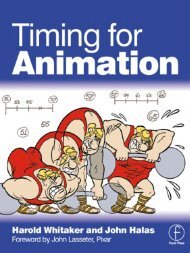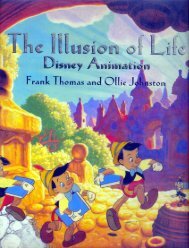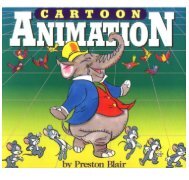Character animation crash course
Create successful ePaper yourself
Turn your PDF publications into a flip-book with our unique Google optimized e-Paper software.
ACTING IN ANIMATION - PART 1: GETTING STARTED 17<br />
How Do You Develop a Convincing <strong>Character</strong> in Animation?<br />
• Believe he exists! No one will believe in your character unless you do first.<br />
And if this character exists, he will have certain properties, physical and emotional,<br />
that you will need to convey to an audience.<br />
• Know who he is. Any character has to be conceived from the inside out. By<br />
understanding who your character is, you will define movements, gestures, and<br />
behavior that reflect his outlook. Often, <strong>animation</strong> characters start with archetypes,<br />
so the audience can "get" who they are quickly. I call this the "John and Ron"<br />
technique, since John Musker and Ron Clements are the directing team that uses<br />
this method so effectively. (Heck, they darn near invented it!) Let's use Disney's<br />
Hercules as an example: Meg is the "tough gal with a heart of gold/' Phil is the<br />
"feisty coach/' a has-been with a gruff exterior. However, these characters become<br />
richer when you define for the audience why they have become these archetypes<br />
and how they deal with it. Meg has been hurt in love before - so much that she's<br />
developed that hard shell as a defense mechanism - and it's the prospect of true<br />
love that makes her crack. Phil is a washout, a failure: he's given up and lives a life<br />
of debauchery to help him forget- but the prospect of Here just possibly being<br />
"the one" makes him drop his guard one more time. Now all of this may sound<br />
lofty for a broad cartoon comedy such as Hercules, but I assure you it is indeed<br />
the process the directors and animators went through to realize their characters.<br />
By giving your characters a history, your <strong>animation</strong> can evolve over the <strong>course</strong><br />
of a film : start by showing the audience the archetype, and deepen it- contrast<br />
with it- when revealing the character's motives, changing attitudes, and internal<br />
conflicts.<br />
• Ask yourself the right questions. Grill yourself over all the aspects of<br />
your character until you know the answers:<br />
• What makes your character who he is? What excites him? What makes him mad?<br />
What is his driving motivation? How does he look at life? What are his basic attitudes?<br />
How can you expand these basic attitudes to acquire more depth? What<br />
makes your particular character tick? What makes him unique? How do you show<br />
him thinking, changing mood?
















